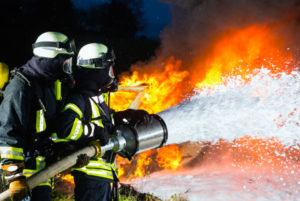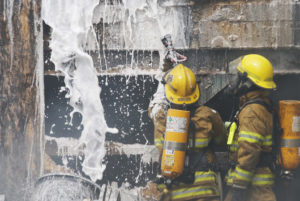The manufacturers of AFFF (aka firefighting foam) have used dangerous chemicals (known as PFAS) to make the foam since the 1960s.
If you or a loved one was exposed to firefighting foam on the job and diagnosed with cancer, you may be able to seek compensation from a firefighting foam lawsuit. Call (800) 995-1212 now to see if you qualify.
Firefighting Foam Cancer Lawsuits

Firefighting foam, also known as AFFF (aqueous film-forming foam) is a foam firefighters use to put out fires. It has been used since the 1960s, particularly in the military and at airports because of its effectiveness in extinguishing jet fuel and petroleum fires. Dangerous chemicals known as PFAS are used to make firefighting foam.

"There is evidence that exposure to PFAS can lead to adverse health outcomes in humans."
– The U.S. Environmental Protection Agency (EPA)
However, exposure to the PFAS chemicals in AFFF may cause various types of cancer in firefighters who were regularly exposed to it.
If you suspect exposure to PFAS chemicals caused your cancer, you may be eligible for compensation through a firefighting foam lawsuit. Get a free case review today to learn more about your options.
The Link Between Firefighting Foam and Cancer
Chemical-based firefighting foam called AFFF has been sold for decades, but the deadly side effects of the chemical are now widely known.
PFAS-based firefighting foam exposure may cause firefighters to develop:
- Bladder cancer
- Breast cancer
- Leukemia
- Liver cancer
- Lymphoma
- Multiple myeloma
- Pancreatic cancer
- Prostate cancer
- Renal or kidney cancer
- Testicular cancer
- Thyroid disease
- Ulcerative colitis
- Uterine or endometrial cancer
At particular risk of PFAS exposure are:
If you or a loved one are a firefighter, were exposed to this foam, and later developed cancer, you may be entitled to compensation through a firefighter foam lawsuit.
What to Look for in Firefighting Foam Cancer Lawyers
Filing a firefighter foam lawsuit can be a difficult process without the help of a skilled and experienced legal team — but not all firefighting foam lawyers can offer you the same advantages.
Here’s what you should look for when choosing an AFFF lawyer:
If you’ve been diagnosed with cancer after working with AFFF as a firefighter, our firefighting foam cancer lawyers may be able to help you pursue financial compensation from an AFFF lawsuit.
Who Qualifies for the AFFF Lawsuit?
You may be able to file an AFFF lawsuit if you or a loved one was:
- Exposed to toxic firefighting foam while working as a firefighter
- Diagnosed with a type of cancer linked to PFAS exposure
You only have a limited amount of time to file a firefighting foam lawsuit due to state laws known as statutes of limitation. Don’t wait to pursue justice until it’s too late.
Call (800) 995-1212 now for free help determining your eligibility to file an AFFF lawsuit.
How Do AFFF Lawsuits Work?
Though every case is different, firefighter foam lawsuits generally follow a similar process, which your legal team at Sokolove Law can take care of on your behalf.
When you work with Sokolove Law, your legal team handles:
- Determining your eligibility to file an AFFF lawsuit
- Gathering evidence from your medical and work histories that proves your exposure to PFAS
- Filing your AFFF lawsuit within any deadlines or statutes of limitations
- Negotiating a firefighting foam settlement
- Fighting on your behalf in court before a jury if a settlement isn't reached
After your free case review with Sokolove Law, every step of the AFFF cancer lawsuit process can be handled by our experienced legal team, so you can focus on your health and your family.
Firefighter Foam & AFFF Lawsuit Update 2023-2024
Firefighter foam lawsuits have been consolidated into an AFFF class action or multidistrict litigation (MDL) in the U.S. District Court for the District of South Carolina. These claims are filed against 25 separate companies, including 3M, DuPont, and Tyco Fire Products.
The latest firefighting foam and AFFF lawsuit updates include:
- April 2024: There are currently 7,738 lawsuits pending in the AFFF MDL. More than 500 new victims joined the litigation in the past month, highlighting the widespread impact of PFAS chemicals in firefighting foam.
- March 2024: The Department of Defense (DOD), which has been named in several AFFF lawsuits, is seeking to remove itself from these claims. Plaintiffs allege the department's use of PFAS firefighting foam on military bases contaminated nearby drinking water, and the DOD should not be protected under federal immunity for polluting local water supplies.
- February 2024: The firefighter foam trial for the first 28 AFFF lawsuits is set to begin in August. These will be the first claims for injured individuals, rather than municipal governments seeking compensation for contaminated water systems.
- January 2024: AFFF lawyers have started collecting evidence, talking with witnesses, and sharing information to prepare for trial.
- December 2023: The first cases that will be heard in the AFFF class action lawsuits will involve victims with kidney cancer, testicular cancer, thyroid disease, and ulcerative colitis.
- November 2023: Three AFFF contamination victims have passed away since filing their claims, highlighting the human toll associated with this issue and the urgency in addressing lawsuit delays.
- October 2023: Over 6,000 claims are currently pending in the AFFF lawsuit, though many of these are connected to local officials looking to address water systems contaminated by firefighter foam.
- August 2023: A study involving members of the U.S. Air Force and military firefighters revealed a concerning link between exposure to PFOS, a specific type of PFAS chemical, and an increased risk of testicular cancer.
- June 2023: An initial $10.3 Billion settlement has been reached between U.S. public water systems and 3M, a manufacturer of AFFF. The cities and towns that filed lawsuits against 3M claimed their water was polluted with PFAS, partly as a result of firefighting foam. This settlement doesn’t apply to individual plaintiffs with personal injury or wrongful death AFFF claims.
At Sokolove Law, we’re committed to providing you with the latest firefighter foam lawsuit updates, and we’ll keep you posted as your AFFF claim progresses.
If you haven’t filed your claim yet, call (800) 995-1212 now to find out if you may be eligible for compensation from an AFFF lawsuit.
What Is AFFF?
Known officially as aqueous film-forming foam (AFFF), firefighting foam creates a blanket that cuts off the fuel from the oxygen it needs to burn, effectively smothering the fire.
One of the main ingredients of firefighter foam, however, are dangerous chemicals known as perfluoroalkyl and polyfluoroalkyl substances (PFAS).
The EPA uses PFAS as an umbrella term to refer to a group of toxic chemicals that includes:
- Perfluorooctanoic acid (PFOA or C8)
- Perfluorooctane sulfonate (PFOS)
- Other PFA substances
The EPA has classified PFAS chemicals as “emerging contaminants,” meaning exposure to PFAS can be dangerous to human health.

Toxic Firefighting Foam Dangers
Major health organizations like the Centers for Disease Control and Prevention (CDC), the EPA, and the American Cancer Society (ACS) have noted that certain PFAS chemicals may be linked to an increased risk of cancer and other health problems in firefighters.
The following types of cancers have been linked to exposure to firefighting foam that contains PFAS:
- Bladder cancer
- Breast cancer
- Leukemia
- Liver cancer
- Lymphoma
- Multiple myeloma
- Pancreatic cancer
- Prostate cancer
- Renal or kidney cancer
- Testicular cancer
- Thyroid disease
- Ulcerative colitis
- Uterine or endometrial cancer
In addition to multiple types of cancer, PFAS exposure can also lead to thyroid disease and ulcerative colitis (an inflammatory bowel disease).
PFAS are often referred to as “forever chemicals,” because their highly durable nature means they do not break down over time.
Because of this, PFAS may remain in the body for years, building up over time and causing numerous firefighting foam health effects and risks.
If you were diagnosed with cancer as a result of PFAS exposure, you may be able to work with a law firm to file an AFFF lawsuit to receive financial compensation for your medical expenses and more.
AFFF Cancer High-Risk Occupations
Any firefighter may be at an increased risk of cancer if they’ve been exposed to AFFF. Airport and military firefighters may be at a higher risk of developing certain cancers due to more frequent exposure to the foam.
Firefighters Stationed at Airports
Until 2018, the Federal Airport Administration (FAA) required airports to use PFAS-containing firefighter foam following U.S. Navy guidelines, putting the health of airport firefighters at risk.
Military Firefighters
The U.S. Navy and other branches of the military have used firefighting foam since the 1960s, even during training exercises and non-critical missions. It was particularly favored by military fire departments since it could put out jet fuel fires.
The military is currently phasing out the use of certain PFAS, while the Department of Defense (DOD) is looking into viable PFAS-free firefighting foam alternatives to curb PFAS contamination.
Find an AFFF Lawyer Near You

The firefighting foam lawyers at Sokolove Law are currently investigating cases involving cancer after occupational exposure to firefighting foam.
Our team has over 40 years of experience fighting for people who were injured through no fault of their own — and we've recovered over $9.3 Billion for our clients nationwide.
Through a firefighting foam cancer lawsuit, you may be able to receive financial compensation for your injuries due to PFAS exposure. We will listen to your story and help you understand your legal options.
To learn more, contact the firefighting foam attorneys at Sokolove Law today by starting a free legal case review.
Firefighter Foam Lawsuit FAQs
Is AFFF a carcinogen?
Numerous studies show that PFAS in AFFF may cause cancer, particularly in the:
- Bladder
- Blood cells
- Breasts
- Kidneys
- Liver
- Lymphatic system
- Pancreas
- Plasma, a type of white blood cell
- Prostate
- Testicles
- Uterus
If you’ve been exposed to AFFF and diagnosed with one of these cancers, you may be entitled to financial compensation through a firefighter foam lawsuit. Get a free consultation today to learn more.
What does AFFF stand for?
AFFF stands for aqueous film-forming foam. AFFF is a fluorochemical surfactant that contains dangerous chemicals known as perfluoroalkyl and polyfluoroalkyl substances (or PFAS).
Exposure to PFAS chemicals, however, may cause a variety of different cancers.
What is AFFF used for?
AFFF is a foam concentrate and surfactant used by firefighters to extinguish fuel fires.
Unfortunately, however, the firefighters who were exposed to the dangerous PFAS chemicals in firefighting foam may now be at risk of developing certain types of cancer.
How does firefighting foam work?
Water is heavier than most fuels, making it inefficient at stopping certain kinds of fires. When water is sprayed on a fuel fire, it can fall underneath the flames, start to boil, and spread the fire around instead of putting it out.
AFFF (firefighting foam), however, is lighter and acts as a blanket atop the fuel, cutting the fire off from the oxygen it needs to continue to burn, which smothers the fire.
Is firefighting foam still used?
Yes. Unfortunately, toxic PFAS-based firefighting foam is still being used at a variety of airports across the country, both for military and commercial use.
However, the Department of Defense is researching safe PFAS-free foam alternatives and has limited the use of AFFF to emergency responses.
How do I know if I have an AFFF cancer case?
The easiest way to see if you have a firefighting foam cancer case is to get a free case review from a nationwide law firm like Sokolove Law.
If you’ve been diagnosed with cancer as a result of AFFF exposure, we may be able to help you pursue compensation through an AFFF cancer lawsuit.
Can I afford a firefighting foam attorney?
Absolutely — the best AFFF lawyers work on a contingency basis, so you won’t be charged any upfront fees. Our lawyers will only get paid if you do.
How can an AFFF lawyer help me?
By working with a law firm like Sokolove Law, you can put the legal process in the hands of skilled and experienced firefighting foam lawyers, so you can focus on your health.
AFFF lawyers can help you with every step of the legal process, including:
- Determining your legal options during a free case evaluation
- Finding the evidence needed to prove your case
- Filing your AFFF lawsuit
- Reaching a firefighting foam cash settlement
- If a settlement is not reached, arguing your case in court before a judge
How much can I get from a firefighting foam settlement?
It’s difficult to predict how much a firefighting foam lawsuit settlement may be worth because every case is different.
Firefighting foam cash settlements vary according to a number of different factors in each case, including:
- The severity of injuries
- The extent of the AFFF exposure
- The cost of current and future medical expenses
- Any wages lost because of the illness
For over 40 years, Sokolove Law has fought on behalf of our clients to maximize the amount of compensation they can receive and has recovered more than $9.3 Billion for clients nationwide.
Get a free case review today to see if our AFFF lawyers can help you too.
